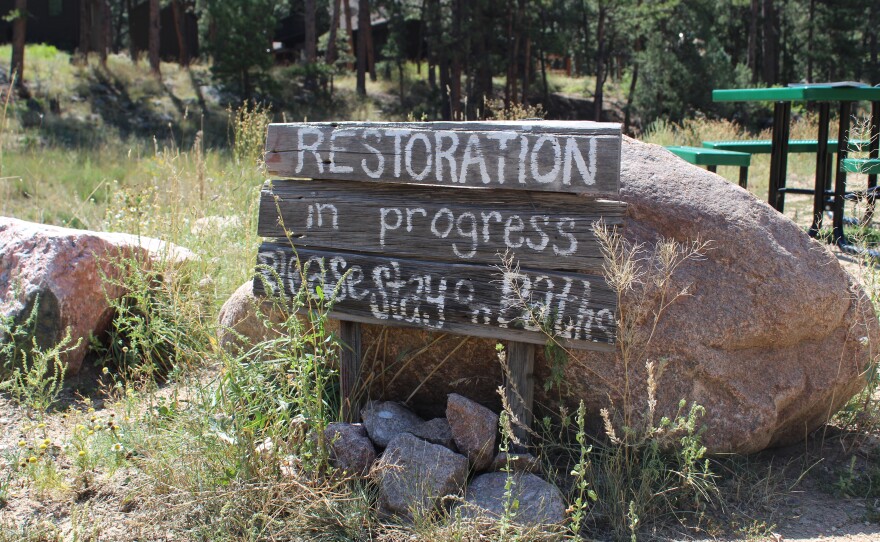In September 2013, four days of torrential rainfall devastated parts of ColoradoŌĆÖs Front Range, killing nine people and damaging or destroying around 1,800 homes. A number of roads were washed out by floodwaters, stranding thousands of people who had to be helicoptered to safety.
That was the case for the people of Pinewood Springs, a small community in the Rocky Mountains between Lyons and Estes Park. On a cloudy, rainy Monday, most of the townŌĆÖs roughly 600 residents found themselves walking to a field, boarding a Chinook helicopter and being taken to either Fort Collins or Boulder.
Kerry Grimes and his wife Alison, along with their dog Mocha, were among those people and animals evacuated. I spoke to him by phone just a few days after that experience.

Five years later, life in the town of Pinewood Springs is mostly back to normal. I met Kerry Grimes there and asked him to pick up the story of the day when they realized this wasnŌĆÖt just another rainstorm.
ŌĆ£It had been raining for several days - I think it was Sept. 11, 2013. I tried to go to work and got blocked by our volunteer fire folks, who said the road had been blocked,ŌĆØ Grimes recalled. ŌĆ£The road to Estes Park was washed out too.ŌĆØ
At that point he and his wife went out for one of their usual hikes and could immediately tell something was different.

ŌĆ£Little side streams coming down where they had never been before. The river was like an ocean, almost with waves and rocks and trees. It was kind of spooky,ŌĆØ he said.
In Pinewood Springs, the Little Thompson River is normally not much more than a trickle. But when he and his wife Allison walked to it on that Thursday, it was a very different river ŌĆō swollen and angry, dragging rocks along its path, uprooting trees, and taking out a very vital piece of infrastructure.

ŌĆ£When we first got down here, this bridge here had just been washed out -- and we could see the residents on the other side of the bridge there, and they were actually isolated,ŌĆØ Grimes said as we stood by the repaired bridge. ŌĆ£The community started calling that Kiowa Island, because this road is called Kiowa Road. (The bridge) was their only exit out, and the river was too high to cross for weeks.ŌĆØ
Residents built a trail on a nearby hillside so they could walk out or be driven out on all-terrain vehicles. Though everyone who wanted to got out safely, Grimes said that area remained washed out for weeks.
Grimes credits the tight-knit community for banding together, and the independent volunteer fire department for its strong leadership during the event.
ŌĆ£They started a little incident command pretty much right as soon as the floods hit, and they organized tasks for the community and really got things rolling. One of the tasks was to go house-to-house and make sure everybody was okay -- that was sort of the first order of business,ŌĆØ Grimes said. ŌĆ£Then it was (to) build a trail to make sure those folks could get out. It was kind of amazing how everybody kind of rallied together.ŌĆØ

At a community meeting, residents were told to prepare to be on their own and self-sufficient for several weeks. It turned out to be only five days before the helicopters arrived. Looking back, Grimes said it feels as though the disaster brought the residents of Pinewood Springs closer.
ŌĆ£Most of the houses here are fairly spaced out, so sometimes it's tough to meet your neighbors,ŌĆØ he said, walking me through the area and pointing out houses. ŌĆ£During the flood we met a lot of people we had, frankly, never met before. When you're out there digging trenches around houses for water, so it doesn't flow into people's houses -- you kind of gain that sense of community.ŌĆØ
Grimes said he and Alison always knew theyŌĆÖd come back to Pinewood Springs ŌĆō it was just a question of when. Their home was relatively unscathed and they were able to return about six weeks after being evacuated.
ŌĆ£A lot of people didnŌĆÖt come back for six months, or a year ŌĆō and a few didnŌĆÖt even come back at all. But for us, I think it was never really a question,ŌĆØ he said.

They did implement one change heŌĆÖd talked about in our phone conversation five years ago. They purchased a generator, which would have come in handy during the floods to ensure they would at least have a working refrigerator. Fortunately, he said they havenŌĆÖt had to use it yet ŌĆō but theyŌĆÖre now much more prepared, should the unthinkable happen again.














